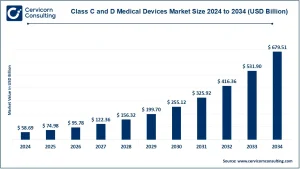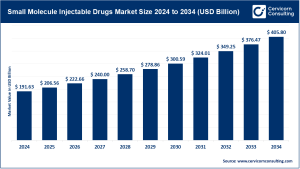Healthcare CDMO Market Overview
The global healthcare CDMO market was valued at approximately USD 270.51 billion in 2024 and is expected to reach USD 584.74 billion by 2034, registering a CAGR of 8.01% between 2025 and 2034. CDMOs provide a wide array of outsourced services, including drug formulation, process development, commercial-scale manufacturing, and packaging. By leveraging these services, pharmaceutical and biotechnology companies can accelerate their time-to-market, optimize operational costs, and access advanced capabilities for small molecules, biologics, and next-generation therapies.
In 2024, North America led the market with a revenue share of 40.6%, followed by Europe at 27.8%. Contract manufacturing remained the largest service segment, contributing nearly 74.5% of total service revenue, highlighting the increasing dependence on outsourced production capacity. The U.S. alone generated around USD 76.88 billion in CDMO revenues during the same period.
Get a Free Sample: https://www.cervicornconsulting.com/sample/2582
Key Market Trends
-
Expansion in Biologics, Cell & Gene Therapy Manufacturing
The rising demand for biologics, cell, and gene therapies is prompting CDMOs to enhance manufacturing capabilities, including viral-vector production and aseptic fill/finish operations. The surge in personalized medicine and advanced therapies is driving pharmaceutical companies to outsource to CDMOs with specialized infrastructure and expertise. -
End-to-End Integrated CDMO Services
Pharma and biotech firms increasingly prefer CDMOs that offer integrated services from drug discovery to commercial production. This “one-stop” approach reduces handoffs, enhances operational efficiency, and fosters stronger strategic partnerships, particularly in complex drug and biologics segments. -
Digitalization, AI & Advanced Analytics in Manufacturing
CDMOs are adopting AI, machine learning, and process analytics to improve manufacturing efficiency. Applications include predictive maintenance, real-time monitoring, and digital quality systems, which enhance yield, reduce downtime, and ensure regulatory compliance. -
Shift Toward Flexible, Small-Batch Manufacturing
With the growth of niche biologics, personalized therapies, and rare-disease drugs, demand is rising for modular, multi-product, small-batch facilities. CDMOs are investing in flexible manufacturing systems to cater to smaller biotech clients requiring customized production. -
Geographic Expansion and Nearshoring
CDMOs are expanding into Asia-Pacific and Latin America to leverage cost-efficient production and emerging biotech hubs, while nearshoring in North America and Europe enhances supply-chain resilience and reduces delivery timelines.
Market Drivers
-
Rising Demand for Biologics and Complex Formulations: The shift toward biologics, biosimilars, and vaccines continues to fuel CDMO growth. The increasing share of biologics in the global drug pipeline emphasizes the need for specialized manufacturing capabilities.
-
Economic Efficiency and Scalability: Outsourcing enables small and mid-sized pharma companies to avoid heavy capital investment while scaling production efficiently.
-
Regulatory Compliance and Quality Standards: Stringent requirements, especially for biologics and sterile manufacturing, drive reliance on established CDMOs with proven global certifications.
-
Digital Transformation and Automation: Integrating AI, machine learning, and data analytics enhances process optimization, traceability, and quality assurance.
-
Government and Industry Support: Incentives promoting biomanufacturing, R&D, and public-private partnerships encourage investments in advanced CDMO infrastructure.
Impact of Trends and Drivers
-
By Service Segment: Contract manufacturing dominated with over 74% market share in 2024, reflecting strong demand for commercial-scale production. Contract development continues to grow as biotech startups and virtual pharma firms seek formulation and process-development expertise.
-
By Therapeutic Application: Focus on biologics, gene therapies, and vaccines has shifted CDMO investments toward sterile production, biologics purification, and viral-vector platforms.
-
By Region:
-
North America: Leads with over 40% share, supported by robust pharma R&D and regulatory systems.
-
Europe: Mature, innovation-driven region emphasizing sustainable, high-quality biomanufacturing.
-
Asia-Pacific: Fastest-growing region, benefiting from government incentives and biotech clusters in India, China, Japan, and South Korea.
-
-
By Customer Type: Large pharmaceutical companies rely on CDMOs for specialized capabilities, while SMEs outsource end-to-end development due to limited in-house infrastructure.
Challenges & Opportunities
Challenges:
-
Talent Shortages: Growing demand for specialized expertise in biologics, sterile, and cell therapy manufacturing exceeds workforce availability.
-
IP and Contractual Risks: Protecting intellectual property during outsourced production remains critical.
-
Regulatory Complexity: Multi-regional regulations increase compliance costs and time-to-market.
-
Competitive Pricing Pressure: Emerging-market CDMOs create price competition, especially in small-molecule services.
Opportunities:
-
Cell & Gene Therapy Manufacturing: Early investment in advanced therapy manufacturing offers access to premium market share.
-
Complex Generics and Biosimilars: Expiring biologics patents drive demand for high-quality biosimilar production.
-
Digital and Smart Manufacturing: AI-driven analytics, digital twins, and automation enhance efficiency and client value.
-
Regional Expansion: New facilities in emerging markets allow CDMOs to serve both global and local pharma clients efficiently.
Future Outlook
The healthcare CDMO market is projected to grow from USD 270.51 billion in 2024 to USD 584.74 billion by 2034 at a CAGR of 8.01%. Growth will be driven by accelerating biologics demand, increasing outsourcing by small and virtual biotech firms, and adoption of AI-enabled manufacturing technologies.
Over the next decade, industry consolidation will continue, with leading CDMOs pursuing acquisitions to scale operations and integrate services. Asia-Pacific will become a hub for cost-effective production, while North America and Europe will maintain leadership in high-value biologics and regulatory-driven services.
The future CDMO landscape will be defined by digital transformation, biologics specialization, and global collaboration, enabling faster, smarter, and more flexible drug development and manufacturing worldwide.
Contact for Detailed Overview: Cervicorn Consulting
Read Report:
Hyperscale Computing Market Size, Growth Trends & Forecast 2025–2034 | CAGR 23.14%
Sustainable Manufacturing Market Trends, Drivers, and Future Outlook by 2034


